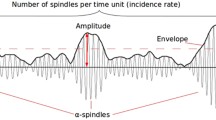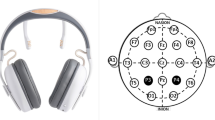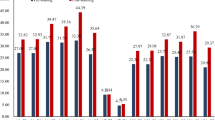Abstract
Two experiments were done with subjects from a paid pool of undergraduates. In each study, there were five 1-hour sessions on each of 5 days: (1) Baseline: Rewards given for randomly selected 20% of the 700-ms sequential epochs; mean and SD of baseline power differences determined. 2) Exploration: Subjects were rewarded when right minus left alpha differences in an epoch were greater than the baseline mean plus about .85 SD (p = .20); subjects told to discover how to generate rewards. (3)–(5). Training: Subjects were paid (over and above the $8/h flat rate) in proportion to their hit rates. In the first study (in which active filters passed 8–12 Hz activity, and the rectified, integrated amplitude was utilized), 6 of 8 subjects met learning criteria (a significant difference between baseline and training scores). In the second study (in which on-line FFTs were used to extract alpha power), 3 of 5 subjects met learning criteria.
Similar content being viewed by others
References
Boyd, J.H., & Weissman, M.M. (1981). Epidemiology of affective disorders.Archives of General Psychiatry, 38, 1039–1046.
Davidson, R. J. (1992). Anterior cerebral asymmetry and the value of emotion.Brain and Cognition, 20, 125–151.
Frank, E., Carpenter, L.L., & Kupfer, D.J. (1988). Sex differences in recurrent depression: Are there any that are significant?American Journal of Psychiatry, 145, 41–45.
Henriques, J.B. & Davidson, R.J. (1990a). Left frontal hypoactivation in depression.Psychophysiology, 27, S38 (Supplement).
Henriques, J.B., & Davidson, R.J. (1990b). Regional brain electrical asymmetries discriminate between previously depressed and healthy control subject.Journal of Abnormal Psychology, 99 22–31.
Hirschfeld, R.M.A., & Goodwin, F.K. (1988). Mood disorders. In J.A. Talbott, R.E. Hales, and S.C. Yudofsky (Eds.),Textbook of psychiatry (pp. 403–441). Washington, DC: American Psychiatric Press.
Karno, M., Hough, R.L., Burnam, A., Escobar, J.I., Timbers, D.M., Santana, F., & Boyd, J.H. (1987). Lifetime prevalence of specific psychiatric disorders among Mexican Americans and non-Hispanic whites in Los Angeles.Archives of General Psychiatry, 45, 695–701.
Keller, M.B., Lavori, P.W., Endicott, J., Coryell, W., & Klerman, G.L. (1983). “Double depression”: Two year follow-up.American Journal of Psychiatry, 140, 689–694.
Keller, M.B., Shapiro, R.W., Lavori, P.W., & Wolfe, N. (1982). Relapse in major deressive disorder.Archives of General Psychiatry, 39 911–915.
Minkoff, K., Bergman, E., Beck, A.T., & Beck, R. (1973). Hopelessness, depression and attempted suicide.American Journal of Psychiatry, 130, 455–459.
Murphy, J.M., Monson, R.R., Olivier, D.C., Sobol, A.M., & Leighton, A.H. (1987). Affective disorders and mortality.Archives of General Psychiatry, 44, 473–480.
Robins, L.N., Helzer, J.E., Weissman, M.M., Orvaschel, H., Gruenberg, E., Burke, J.D., & Regier, D.A. (1984). Lifetime prevalence of specific psychiatric disorders in three sites.Archives of General Psychiatry, 41, 949–958.
Rosenfeld, J.P. (1974). Evoked potential conditioning in neuroscience research. In M. Chase (Eds.),Operant control of brain activity, (Perspectives in the Brain Sciences, Vol. II). Los Angeles: Brain Information Service, Brain Research Institute, UCLA.
Rosenfeld, J.P. (1977). Conditioning changes in the evoked response. In G. E. Schwartz & J. Beatty (Eds.),Biofeedback: Theory and Research (pp. 377–388). New York: Academic Press. Rosenfeld, J.P., Silvia, R., Weitkunat, R., & Dowman, R. Operant control of human somatosensory evoked response alters experimental pain perception.Advances in Neurology, 9, 343–348.
Rosenfeld, J.P., Dowman, R., & Silvia, R. (1986). Operant conditioned potentials in pain substrates of rats and humans: Correlated effects on nociception and effects of naloxone. In C. McCullum et al. (Eds.),Electroencephalography and Clinical neurophysiology supplement 38, Seventh International Conference on Event Related Potentials Proceedings, (pp. 400–402). Amsterdam; Elsevier.
Rosenfeld, J.P. (1990). Applied psychophysiology and biofeedback of event-related potentials (brain waves): Historical perspective, review, future directions.Biofeedback and Self-Regulation, 15, 99–120.
Teuting, P., Koslow, S.H., & Hirschfeld, R.M.A. (1981).Special report on depression research. Rockville, MD: National Institute of Mental Health.
Author information
Authors and Affiliations
Rights and permissions
About this article
Cite this article
Rosenfeld, J.P., Cha, G., Blair, T. et al. Operant (biofeedback) control of left-right frontal alpha power differences: Potential neurotherapy for affective disorders. Biofeedback and Self-Regulation 20, 241–258 (1995). https://doi.org/10.1007/BF01474516
Issue Date:
DOI: https://doi.org/10.1007/BF01474516




